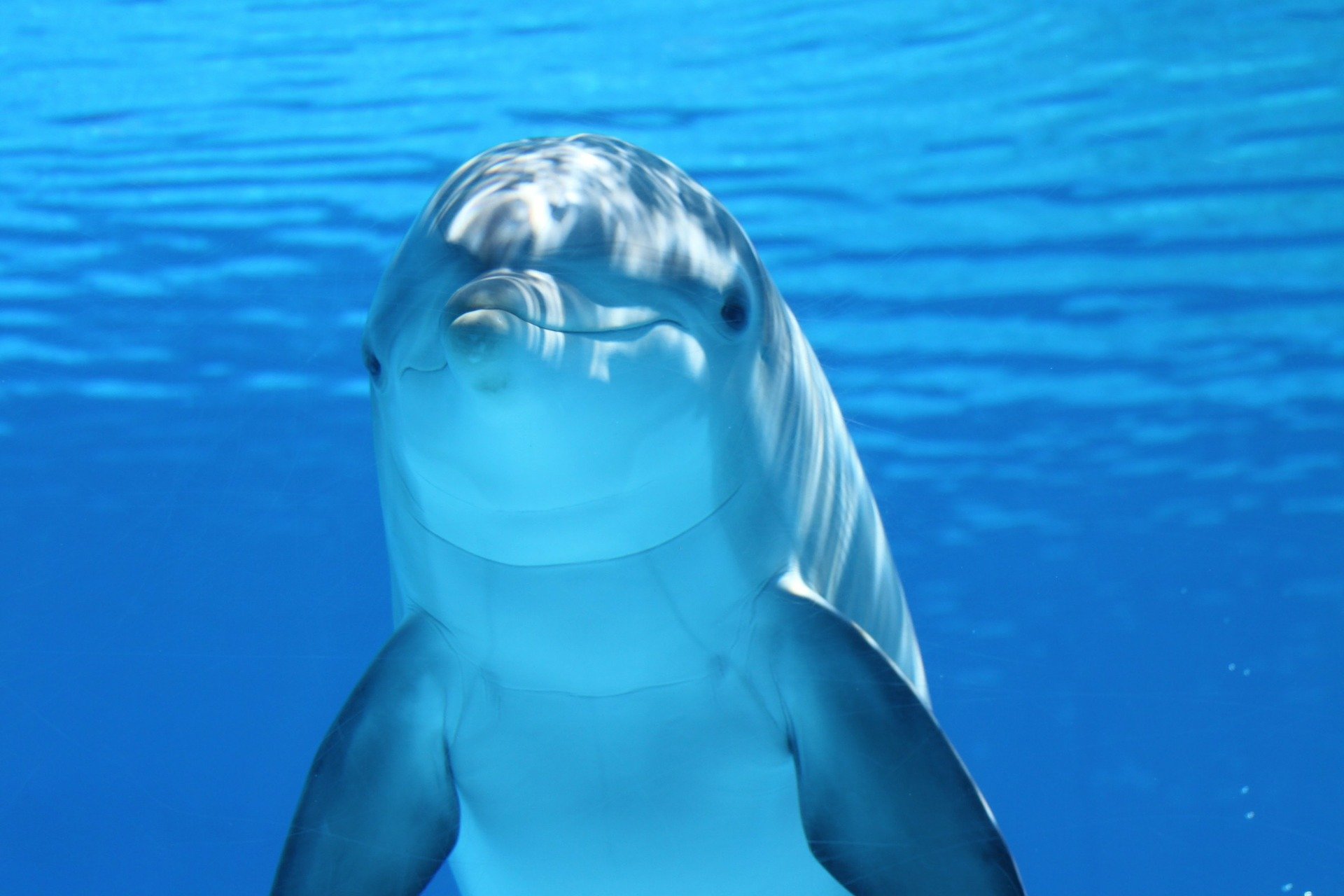10 Mind-Blowing Facts About Dolphins
Dolphins are also thought to be “a kind of alien intelligence sharing our planet” and “the closest we’ll come to encountering ET” and they never cease to amaze us. As researchers delve into the underwater, they have learned and acknowledged some really interesting characteristics of these creatures and found them to be full of surprises, from their intricate social lives to their intelligence. Here are some of the ways dolphins are exceptional, in both physical and mental ways. Although all species on Earth descend from a common ancestor, humans and dolphins have been on different evolutionary paths for eons, which further results in the massive differences that we see today. From making tools and helping humans to always sleep with one eye open, here are 10 mind-blowing facts about dolphins.
1. Dolphins evolved from land animals
Dolphins didn’t always board the water. They’re what are called re-entrants. The ancestors of these marine animals were even-toed ungulates, which had hoof-like toes at the end of each foot and roam and live across the land. But about 50 million years ago, these ancestor animals decided that the ocean was a much better place to live and evolved into the dolphins we all know today.
Confirmation of this evolutionary history can be found in dolphin skeletons today: adult dolphins have remnants of finger bones in their fins, as well as rudimentary leg bones.
2. Dolphins can stay awake for weeks
Dolphins tend to stay awake for weeks. Sleeping with one half of the brain helps dolphins to remain vigilant for long periods. Dolphins can stay awake for at least 15 days at a go.
Researchers from the National Marine Mammal Foundation found that dolphins can use echolocation with near-perfect accuracy continuously for up to two whole weeks, along with target identification and monitoring their environment.
Sleeping with only 1 ½ of their brain at a time is also known as unihemispheric sleep, which was believed to have evolved in dolphins to enable them to breathe at the surface of the water even when half-asleep. This new research suggests that the necessity to stay vigilant may also have played a role in the evolution of this sleeping behavior. Though shocking, this ability is smart. Dolphins need to head to the surface of the ocean to breathe so that they must stay constantly conscious to be able to breathe and avoid drowning. It also acts as a defense, protecting them from potential predators.
3. Dolphins don’t chew their food
Most dolphins are opportunistic feeders and they feed upon aquatic animals. All dolphins eat fish and those living in deep oceans also eat squid and jellyfish. All dolphins have teeth but they don’t chew their food, they just grab, bite, and swallow!
If you’ve ever watched a dolphin eat, you will notice that they seem to gulp down their food. That’s because dolphins can’t chew. Instead, their teeth are used to grip prey.
One theory for why they’ve evolved is to do away with chewing so that they need to quickly consume fish before it can swim away. And skipping the method of chewing ensures their meal doesn’t escape.
4. Dolphins work for the U.S. Military
A military marine mammal can be a cetacean or pinniped that has been trained for military uses. The US Navy has been training dolphins for military purposes since its Marine Mammal Research Program was launched in 1961.
Military dolphins are trained to rescue lost naval swimmers or to swim headfirst into active deep-sea mines. Dolphins work by using echolocation, which is also known to be one of their great and incredible characteristics skills which have far outstrip any technology people have come up with to perform the identical job. However, animal rights advocates have long opposed the making use of dolphins for military purposes.
5. Dolphins call each other by name
Every bottlenose dolphin has its whistle, usually a high-pitched, warbly “eeee” that transfers the message to the other dolphins that a particular individual is present. Dolphins are excellent vocal mimics, too, ready to copy even the quirkiest computer-generated sounds as well. So, the scientists have wondered if dolphins can copy each other’s signature whistles too which would be very similar to people saying each others’ names. Now, an analysis of whistles recorded from many wild bottlenose dolphins confirms that they can indeed “name” one another, and suggests why they do so.
Having the power to find out another individual’s name is not what most animals do. Monkeys have food calls and calls that identify predators, but these are inherited, not learned sounds.
6. Dolphins get high on fish toxins
Dolphins’ innovative nature or their outward signs of culture are all signs of their high intelligence. But so is their “use of drugs.”
We know the fact that pufferfish have strong toxins. Normally, pufferfish toxin is deadly. However, in small doses, the toxin acts sort of a narcotic.
Dolphins know this too, and they still make use of this for the recreational benefit, which makes us think that not only humans find benefits from taking some substances that modified our anemic state.
7. Dolphins use tools
A study by researchers revealed that a population of dolphins living around the world, uses some tools and they pass that knowledge down from mother to their daughter.
Individuals in this small group of dolphins for several minutes will search to find cone-shaped sea sponges that are shaped for the task. The behavior is named “sponging,” and it’s a hunting behavior that is transmitted from mother to calves.
Dolphins tear down the pieces of sponge with their mouths; a dolphin can probe for nutritious bottom-dwelling fish that hide among stones and broken coral. The sponge covers the dolphin’s snout-like mouth guard, keeping the animal’s beak safe from rocky edges.
8. They’re highly creative
Dolphins aren’t just sleek, strong swimmers but they have got pretty hefty brains too. it is said that dolphins are masters of their habitats. Both humans and dolphins have “adapted almost perfectly to the world we live in.”
We’ve observed dolphins involving in a variety of behaviors patterns from exchanging contacts to chasing each other to vocalize and to create bubble bursts. They produce behaviors singly or together, by themselves or with peers.
9. Dolphins work together as a team
In addition to communicating with names, dolphins may also work together as a team, a capability previously thought to be unique to humans.
Research conducted in 2018 suggests that dolphins were also successfully able to synchronize their actions to solve a cooperation task and they also received a reward for it. The test involved getting a pair of dolphins to press two autonomous underwater buttons at the same time. Once the dolphins discovered that the task was cooperative, they succeeded.
10. They qualify as “non-human persons”
Those dolphins can recognize themselves in front of a mirror could be a sure sign of self-awareness and one that the majority of the other animals fail at. They’re also fully alert of their body parts and know exactly who’s in charge of their movement and this is something even human babies are unable to understand. They even associate their pectoral fins with humans’ arms and their tails with human legs, waving or raising them to mirror whatever their trainers are doing.
They’re sentient, they carry emotions, and they also exhibit self-control, and treat others in a more or less ethical manner which certainly is better than what humans do. For what it’s worth, they also seem to understand death, appearing to mourn their dead by supporting carcasses at the water’s surface for upwards of half an hour.
Not only do the dolphins fulfill every criterion for person-hood, but they also include individual personalities. One study found dolphins’ personalities not only vary in case of openness to experience, conscientiousness, extroversion, agreeableness, and neuroticism but also they remain stable over time. In other words, dolphins are just people who live in the ocean or sea, which further raises a very serious question about keeping them in tanks.
Conclusion
It might go too far if one says that the dolphins are as intelligent (or more intelligent) than humans. But to say they’re the second most intelligent species after humans may not be going that far enough. As the dolphins and other aquatic mammals are all intelligent in their simplest and complicated ways. And on that basis alone we should treat them as our evolutionary equals.
Thus, to sum up, their agility and playful behaviour in the wildlife of all the oceans in the world makes them unique. That makes them very interesting animals because of all the characters that they have that people would have never known about. Dolphins are by far the most intelligent marine mammals in the ocean.


